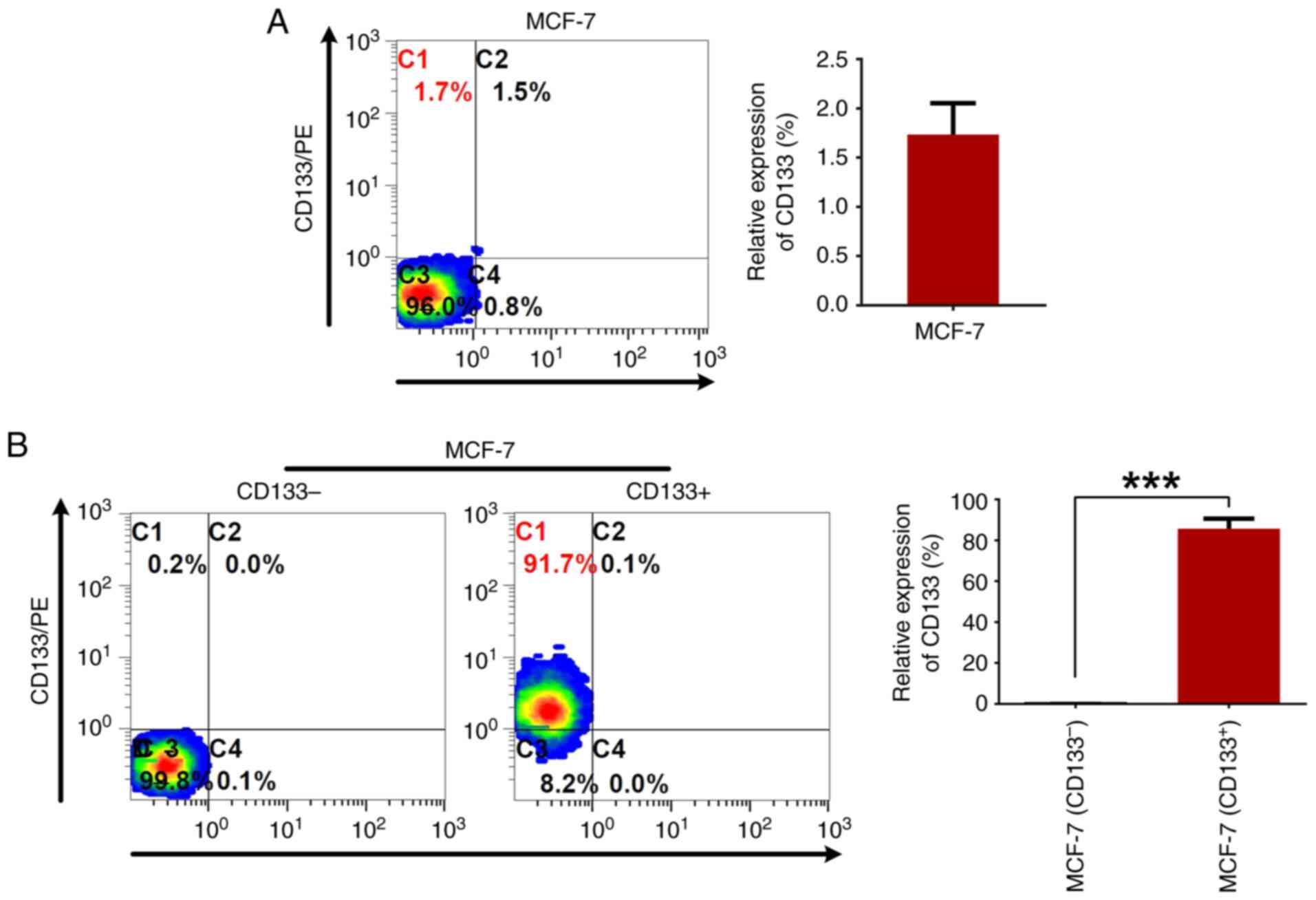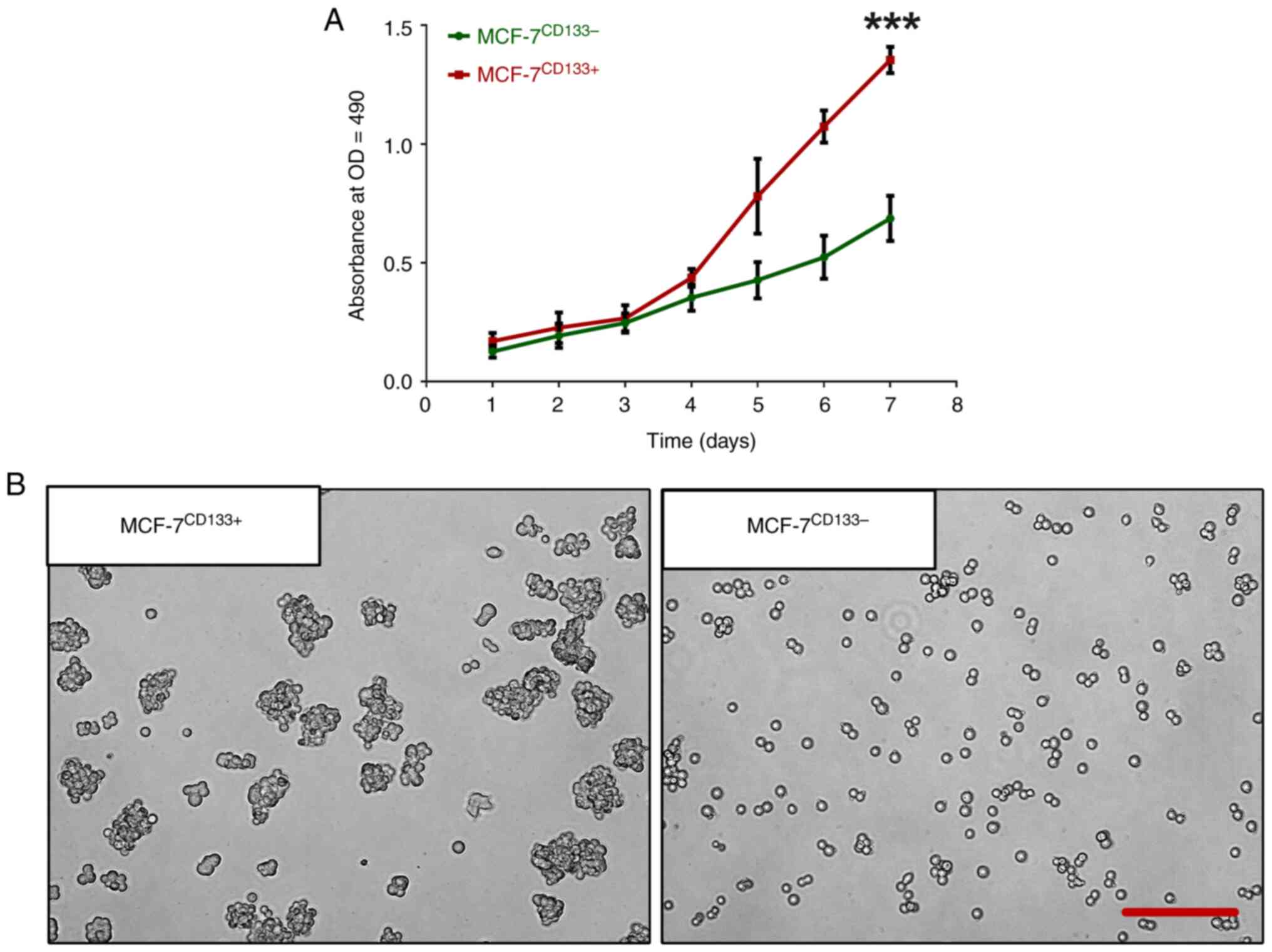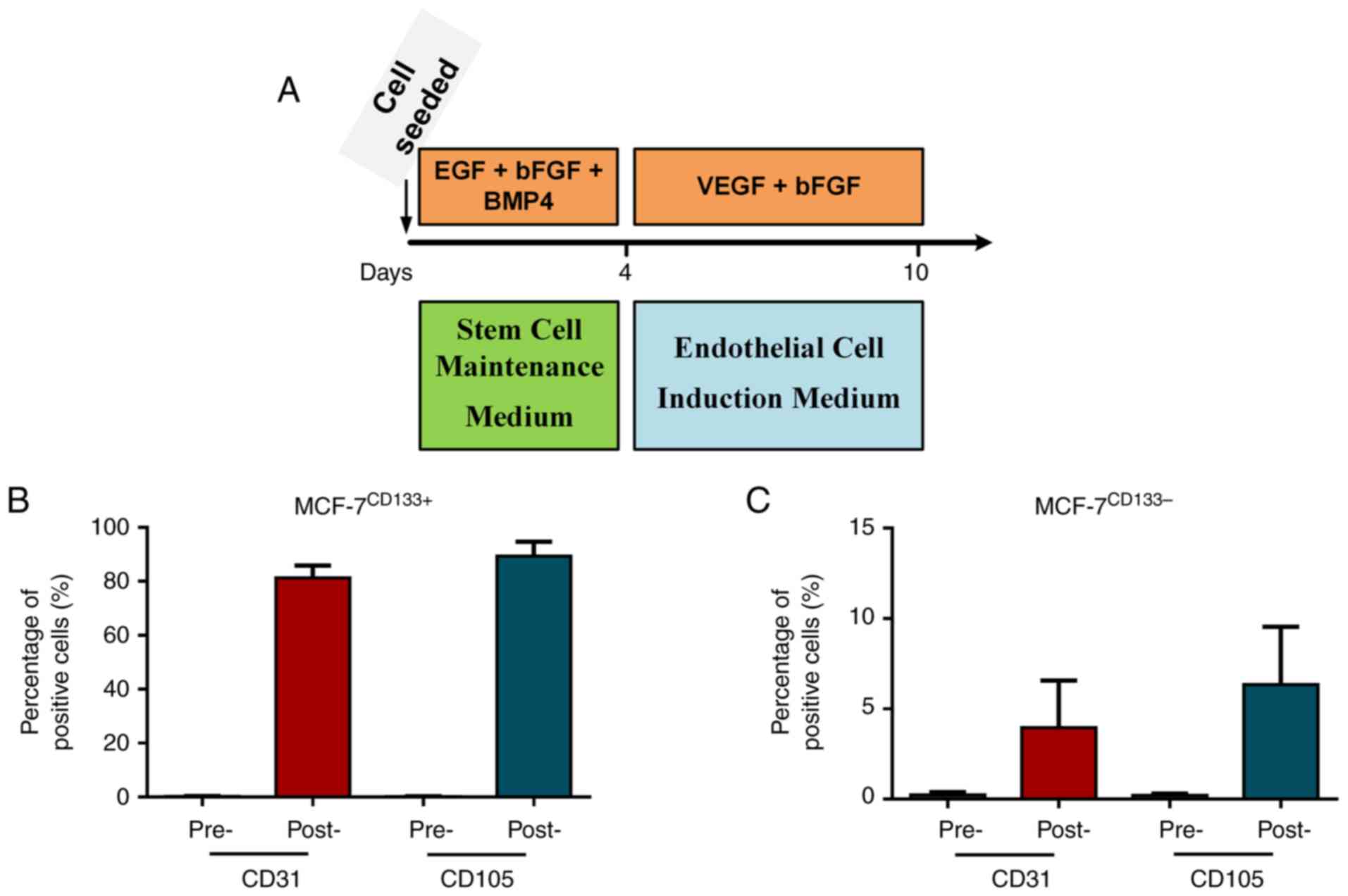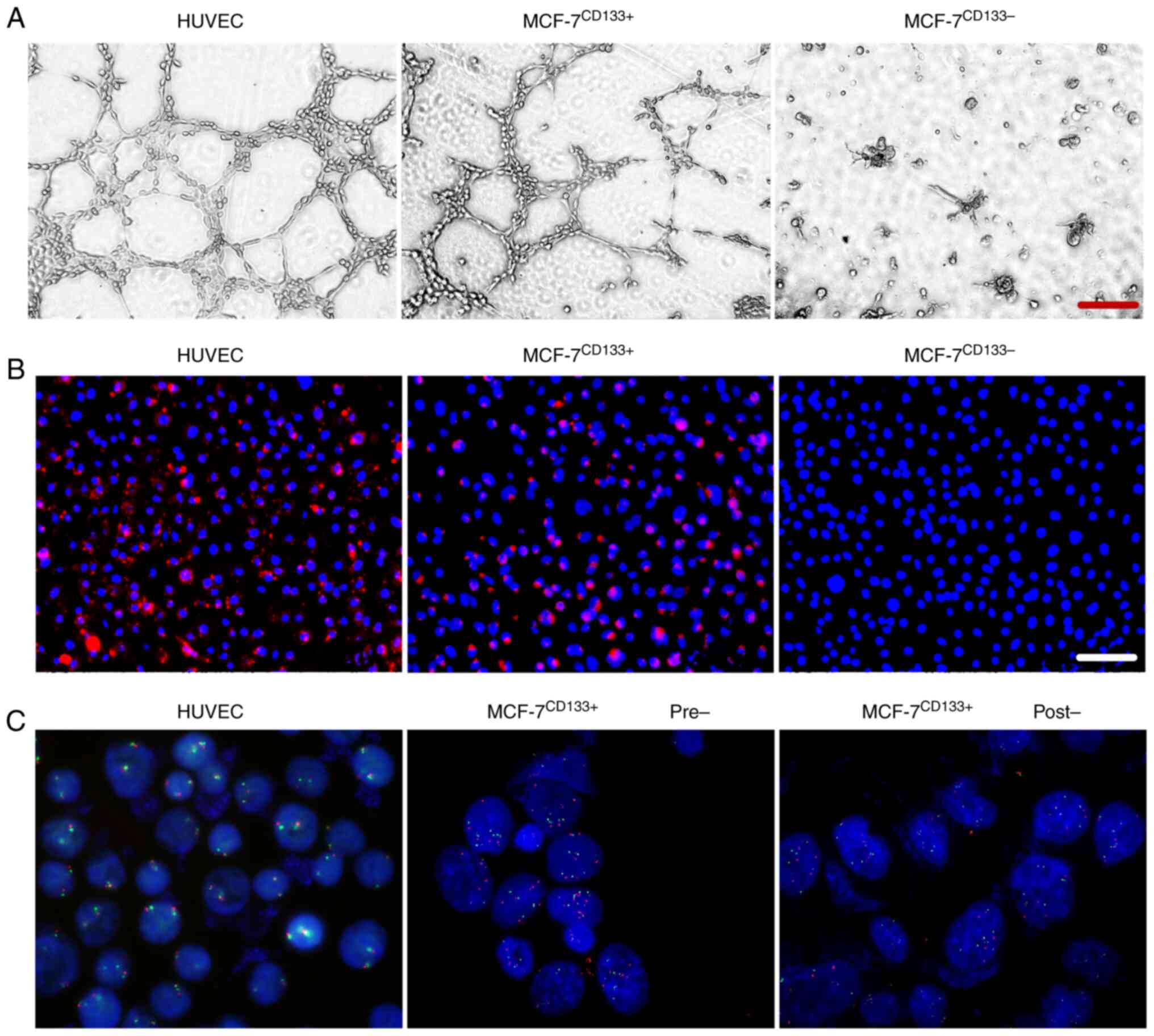|
1
|
Arnold M, Morgan E, Rumgay H, Mafra A,
Singh D, Laversanne M, Vignat J, Gralow JR, Cardoso F, Siesling S
and Soerjomataram I: Current and future burden of breast cancer:
Global statistics for 2020 and 2040. Breast. 66:15–23.
2022.PubMed/NCBI View Article : Google Scholar
|
|
2
|
Rivenbark AG, O'Connor SM and Coleman WB:
Molecular and cellular heterogeneity in breast cancer. Am J Pathol.
183:1113–1124. 2013.PubMed/NCBI View Article : Google Scholar
|
|
3
|
Szczepanek J, Skorupa M, Jarkiewicz-Tretyn
J, Cybulski C and Tretyn A: Harnessing epigenetics for breast
cancer therapy: The role of DNA methylation, histone modifications,
and microRNA. Int J Mol Sci. 24(7235)2023.PubMed/NCBI View Article : Google Scholar
|
|
4
|
Mackillop WJ, Ciampi A, Till JE and Buick
RN: A stem cell model of human tumor growth: implications for tumor
cell clonogenic assays. J Natl Cancer Inst. 70:9–16.
1983.PubMed/NCBI
|
|
5
|
Llaguno SA and Parada LF: Cancer stem
cells in gliomas: Evolving concepts and therapeutic implications.
Curr Opin Neurol. 34:868–874. 2021.PubMed/NCBI View Article : Google Scholar
|
|
6
|
Diehn M, Cho RW, Lobo NA, Kalisky T, Dorie
MJ, Kulp AN, Qian D, Lam JS, Ailles LE, Wong MZ, et al: Association
of reactive oxygen species levels and radioresistance in cancer
stem cells. Nature. 458:780–783. 2009.PubMed/NCBI View Article : Google Scholar
|
|
7
|
Hu Y and Fu L: Targeting cancer stem
cells: A new therapy to cure cancer patients. Am J Cancer Res.
2:340–356. 2012.PubMed/NCBI
|
|
8
|
Loureiro R, Mesquita KA, Oliveira PJ and
Vega-Naredo I: Mitochondria in cancer stem cells: A target for
therapy. Recent Pat Endocr Metab Immune Drug Discov. 7:102–114.
2013.PubMed/NCBI View Article : Google Scholar
|
|
9
|
Phi LH, Sari IN, Yang YG, Lee SH, Jun NY,
Kim KS, Lee YK and Kwon HY: Cancer stem cells (CSCs) in drug
resistance and their therapeutic implications in cancer treatment.
Stem Cells Int. 28(5416923)2018.PubMed/NCBI View Article : Google Scholar
|
|
10
|
Griguer CE, Oliva CR, Gobin E, Marcorelles
P, Benos DJ, Lancaster JR and Gillespie GY: CD133 is a marker of
bioenergetic stress in human glioma. PLoS One.
3(e3655)2008.PubMed/NCBI View Article : Google Scholar
|
|
11
|
Kunihiro AG, Sarrett SM, Lastwika KJ,
Solan JL, Pisarenko T, Keinänen O, Rodriguez O, Taverne LR,
Fitzpatrick AL, Li CI, et al: CD133 as a biomarker for an
autoantibody-to-immunoPET paradigm for the early detection of small
cell lung cancer. J Nucl Med. 63:1701–1707. 2022.PubMed/NCBI View Article : Google Scholar
|
|
12
|
Howard R, Diffalha SA, Pimiento J, Mejia
J, Enderling H, Giuliano A and Coppola D: CD133 expression as a
helicobacter pylori-independent biomarker of gastric cancer
progression. Anticancer Res. 38:4443–4448. 2018.PubMed/NCBI View Article : Google Scholar
|
|
13
|
Ikram D, Masadah R, Nelwan BJ, Zainuddin
AA, Ghaznawie M and Wahid S: CD133 act as an essential marker in
ovarian carcinogenesis. Asian Pac J Cancer Prev. 22:3525–3531.
2021.PubMed/NCBI View Article : Google Scholar
|
|
14
|
Lugano R, Ramachandran M and Dimberg A:
Tumor angiogenesis: Causes, consequences, challenges and
opportunities. Cell Mol Life Sci. 77:1745–1770. 2020.PubMed/NCBI View Article : Google Scholar
|
|
15
|
Liu ZL, Chen HH, Zheng LL, Sun LP and Shi
L: Angiogenic signaling pathways and anti-angiogenic therapy for
cancer. Signal Transduct Target Ther. 8(198)2023.PubMed/NCBI View Article : Google Scholar
|
|
16
|
Viallard C and Larrivée B: Tumor
angiogenesis and vascular normalization: alternative therapeutic
targets. Angiogenesis. 20:409–426. 2017.PubMed/NCBI View Article : Google Scholar
|
|
17
|
Ferrara N, Gerber HP and LeCouter J: The
biology of VEGF and its receptors. Nat Med. 9:669–676.
2003.PubMed/NCBI View Article : Google Scholar
|
|
18
|
Apte RS, Chen DS and Ferrara N: VEGF in
signaling and disease: Beyond discovery and development. Cell.
176:1248–1264. 2019.PubMed/NCBI View Article : Google Scholar
|
|
19
|
Turner N and Grose R: Fibroblast growth
factor signaling: from development to cancer. Nat Rev Cancer.
10:116–129. 2010.PubMed/NCBI View
Article : Google Scholar
|
|
20
|
Johnson KE and Wilgus TA: Vascular
endothelial growth factor and angiogenesis in the regulation of
cutaneous wound repair. Adv Wound Care (New Rochelle). 3:647–661.
2014.PubMed/NCBI View Article : Google Scholar
|
|
21
|
Phillips TM, McBride WH and Pajonk F: The
response of CD24(-/low)/CD44+ breast cancer-initiating cells to
radiation. J Natl Cancer Inst. 98:1777–1785. 2006.PubMed/NCBI View Article : Google Scholar
|
|
22
|
Puca F, Fedele M, Rasio D and Battista S:
Role of diet in stem and cancer stem cells. Int J Mol Sci.
23(8108)2022.PubMed/NCBI View Article : Google Scholar
|
|
23
|
Katayama Y, Uchino J, Chihara Y, Tamiya N,
Kaneko Y, Yamada T and Takayama K: Tumor neovascularization and
developments in therapeutics. Cancers (Basel).
11(316)2019.PubMed/NCBI View Article : Google Scholar
|
|
24
|
Aomatsu N, Yashiro M, Kashiwagi S,
Takashima T, Ishikawa T, Ohsawa M, Wakasa K and Hirakawa K: CD133
is a useful surrogate marker for predicting chemosensitivity to
neoadjuvant chemotherapy in breast cancer. PLoS One.
7(e45865)2012.PubMed/NCBI View Article : Google Scholar
|
|
25
|
Sun C, Li JM, Wang B, Shangguan JJ, Figini
M, Shang N, Pan L and Zhang ZL: Tumor angiogenesis and bone
metastasis-correlation in invasive breast carcinoma. J Immunol
Methods. 452:46–52. 2018.PubMed/NCBI View Article : Google Scholar
|
|
26
|
Lv XQ, Wang YZ, Song YM, Pang X and Li HX:
Association between ALDH1+/CD133+ stem-like
cells and tumor angiogenesis in invasive ductal breast carcinoma.
Oncol Lett. 11:1750–1756. 2016.PubMed/NCBI View Article : Google Scholar
|
|
27
|
Sudhan DR, Rabaglino MB, Wood CE and
Siemann DW: Cathepsin L in tumor angiogenesis and its therapeutic
intervention by the small molecule inhibitor KGP94. Clin Exp
Metastasis. 33:461–73. 2016.PubMed/NCBI View Article : Google Scholar
|
|
28
|
Kim W, Kim KS and Park RW: Nomogram of
naive bayesian model for recurrence prediction of breast cancer.
Healthc Inform Res. 22:89–94. 2016.PubMed/NCBI View Article : Google Scholar
|
|
29
|
Panigoro SS, Kurnia D, Kurnia A, Haryono
SJ and Albar ZA: ALDH1 cancer stem cell marker as a prognostic
factor in triple-negative breast cancer. Int J Surg Oncol.
2020(7863243)2020.PubMed/NCBI View Article : Google Scholar
|
|
30
|
Yu JG, Liao XH, Li YL, Lv L, Zhi XL, Yu J
and Zhou P: A preliminary study of the role of
extracellular-5'-nucleotidase in breast cancer stem cells and
epithelial-mesenchymal transition. In Vitro Cell Dev Biol Anim.
53:132–140. 2017.PubMed/NCBI View Article : Google Scholar
|
|
31
|
Yang LQ, Shi PF and Zhao GC: Targeting
cancer stem cell pathways for cancer therapy. Signal Transduct
Target Ther. 5(8)2020.PubMed/NCBI View Article : Google Scholar
|
|
32
|
Irollo E and Pirozzi G: CD133: To be or
not to be, is this the real question? Am J Transl Res. 5:563–581.
2013.PubMed/NCBI
|
|
33
|
Bauer N, Fonseca AV, Florek M, Freund D,
Jászai J, Bornhäuser M, Fargeas CA and Corbeil D: New insights into
the cell biology of hematopoietic progenitors by studying
prominin-1 (CD133). Cells Tissues Organs. 188:127–138.
2008.PubMed/NCBI View Article : Google Scholar
|
|
34
|
Zou L, Liu XW, Li JJ, Li W, Zhang LL, Li J
and Zhang JM: Tetramethylpyrazine enhances the antitumor effect of
paclitaxel by inhibiting angiogenesis and inducing apoptosis. Front
Pharmacol. 10(707)2019.PubMed/NCBI View Article : Google Scholar
|
|
35
|
Ahmed N, Abubaker K, Findlay J and Quinn
M: Epithelial mesenchymal transition and cancer stem cell-like
phenotypes facilitate chemoresistance in recurrent ovarian cancer.
Curr Cancer Drug Targets. 10:268–278. 2010.PubMed/NCBI View Article : Google Scholar
|
|
36
|
Liu XM, Zhang QP, Mu YG, Zhang XH, Sai K,
Pang JC, Ng HK and Chen ZP: Clinical significance of vasculogenic
mimicry in human gliomas. J Neurooncol. 105:173–179.
2011.PubMed/NCBI View Article : Google Scholar
|
|
37
|
Alvero AB, Chen R, Fu HH, Montagna M,
Schwart PE, Rutherford T, Silasi DA, Steffensen KD, Waldstrom M,
Visintin I and Mor G: Molecular phenotyping of human ovarian cancer
stem cells unravels the mechanisms for repair and chemoresistance.
Cell Cycle. 8:158–166. 2009.PubMed/NCBI View Article : Google Scholar
|
|
38
|
Yuan Y, Jiang YC, Sun CK and Chen QM: Role
of the tumor microenvironment in tumor progression and the clinical
applications (review). Oncol Rep. 35:2499–2515. 2016.PubMed/NCBI View Article : Google Scholar
|
|
39
|
Hinshaw DC and Shevde LA: The tumor
microenvironment innately modulates cancer progression. Cancer Res.
79:4557–4566. 2019.PubMed/NCBI View Article : Google Scholar
|
|
40
|
Rohlenova K, Veys K, Miranda-Santos I,
Bock KD and Carmeliet P: Endothelial cell metabolism in health and
disease. Trends Cell Biol. 28:224–236. 2018.PubMed/NCBI View Article : Google Scholar
|
|
41
|
Muz B, Puente PD, Azab F and Azab AK: The
role of hypoxia in cancer progression, angiogenesis, metastasis,
and resistance to therapy. Hypoxia (Auckl). 3:83–92.
2015.PubMed/NCBI View Article : Google Scholar
|
|
42
|
Vasudev NS and Reynolds AR:
Anti-angiogenic therapy for cancer: current progress, unresolved
questions and future directions. Angiogenesis. 17:471–494.
2014.PubMed/NCBI View Article : Google Scholar
|
|
43
|
Alexandre J, Batteux F, Nicco C, Chéreau
C, Laurent A, Guillevin L, Weill B and Goldwasser F: . Accumulation
of hydrogen peroxide is an early and crucial step for
paclitaxel-induced cancer cell death both in vitro and in vivo. Int
J Cancer. 119:41–48. 2006.PubMed/NCBI View Article : Google Scholar
|
|
44
|
Fukui M, Yamabe N and Zhu BT: .
Resveratrol attenuates the anticancer efficacy of paclitaxel in
human breast cancer cells in vitro and in vivo. Eur J Cancer.
46:1882–1891. 2010.PubMed/NCBI View Article : Google Scholar
|
|
45
|
Haibe Y, Kreidieh M, El Hajj H, Khalifeh
I, Mukherji D, Temraz S and Shamseddine A: Resistance mechanisms to
anti-angiogenic therapies in cancer. Front Oncol.
10(221)2020.PubMed/NCBI View Article : Google Scholar
|
|
46
|
Ansari MJ, Bokov D, Markov A, Jalil AT,
Shalaby MN, Suksatan W, Chupradit S, Al-Ghamdi HS, Shomali N,
Zamani A, et al: Cancer combination therapies by angiogenesis
inhibitors; a comprehensive review. Cell Commun Signal.
20(49)2022.PubMed/NCBI View Article : Google Scholar
|
|
47
|
Eelen G, Treps L, Li XR and Carmeliet P:
Basic and therapeutic aspects of angiogenesis updated. Circ Res.
127:310–329. 2020.PubMed/NCBI View Article : Google Scholar
|
|
48
|
Lee WS, Yang H, Chon HJ and Kim C:
Combination of anti-angiogenic therapy and immune checkpoint
blockade normalizes vascular-immune crosstalk to potentiate cancer
immunity. Exp Mol Med. 52:1475–1485. 2020.PubMed/NCBI View Article : Google Scholar
|
|
49
|
Huinen ZR, Huijbers EJ, Beijnum JR,
Nowak-Sliwinska P and Griffioen AW: Anti-angiogenic
agents-overcoming tumour endothelial cell anergy and improving
immunotherapy outcomes. Nat Rev Clin Oncol. 18:527–540.
2021.PubMed/NCBI View Article : Google Scholar
|
|
50
|
Wehland M, Bauer J, Infanger M and Grimm
M: Target-based anti-angiogenic therapy in breast cancer. Curr
Pharm Des. 18:4244–4257. 2012.PubMed/NCBI View Article : Google Scholar
|
|
51
|
Yetkin-Arik B, Kastelein AW, Klaassen I,
Jansen CH, Latul YP, Vittori M, Biri A, Kahraman K, Griffioen AW,
Amant F, et al: Angiogenesis in gynecological cancers and the
options for anti-angiogenesis therapy. Biochim Biophys Acta Rev
Cancer. 1875(188446)2021.PubMed/NCBI View Article : Google Scholar
|
|
52
|
Fukumura D and Jain RK: Tumor
microvasculature and microenvironment: targets for
anti-angiogenesis and normalization. Microvasc Res. 74:72–84.
2007.PubMed/NCBI View Article : Google Scholar
|













